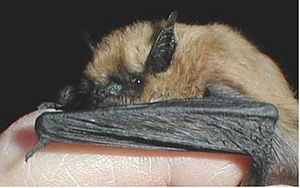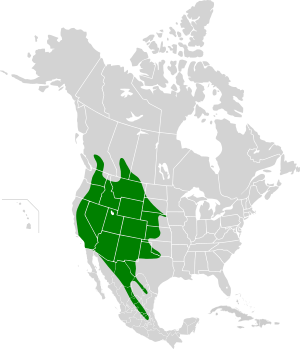Western small-footed bat facts for kids
Quick facts for kids Western small-footed bat |
|
|---|---|
 |
|
| Conservation status | |
| Scientific classification | |
 |
The western small-footed bat (Myotis ciliolabrum) is a small bat found across North America. It's also called the western small-footed myotis. This bat belongs to a group known as vesper bats.
Contents
What Does It Look Like?
Western small-footed bats are quite small. They are about 8 to 10 cm (3.1 to 3.9 in) long from head to tail. Their wings can spread out to about 24 cm (9.4 in). These bats are very light, weighing only 4 to 5 g (0.14 to 0.18 oz). Female bats are usually a bit bigger than males.
Their fur is yellowish-brown. Their bellies are lighter, sometimes even white. The bat's nose and chin are black. Its ears are also black and measure about 11 to 16 mm (0.43 to 0.63 in) long. The tail is 3 to 5 cm (1.2 to 2.0 in) long. It is mostly covered by a skin flap called the uropatagium, with only the very tip sticking out. As their name suggests, their feet are unusually small. They are about half the length of their lower leg bone.
These bats look a lot like the California myotis. Both species live in some of the same areas. You can tell them apart because the western small-footed bat has a black "face mask." The California myotis does not have this black mask.
Where Do They Live?
Western small-footed bats live in many parts of western North America. You can find them from southern British Columbia and Saskatchewan in Canada. Their range extends south to Baja California, Zacatecas, and Nuevo León in Mexico.
They prefer dry and semi-dry places. These include deserts and badlands. But they can also live in pine or juniper forests. This is especially true in higher, mountainous areas. They are found from 300 to 3,300 m (980 to 10,830 ft) above sea level.
There are two types, or subspecies, of this bat:
- M. c. ciliolabrum: This type lives in the western and southern parts of the range. This goes from British Columbia down to Mexico.
- M. c. melanorhinus: This type lives in the northeastern parts of the range. This includes areas from Alberta in Canada to Kansas in the United States.
How They Live and Behave
Western small-footed bats are nocturnal. This means they are active at night. They are also insectivorous, which means they eat insects. Their diet includes moths, beetles, and flies.
They fly slowly but can turn very well. They often hunt for food near water or rocky cliffs. These bats use echolocation to find their prey. Echolocation is like using sound to "see." They send out high-pitched sounds. Then they listen for the echoes that bounce back. This helps them know where objects and insects are. The sounds they make last for a very short time, about 1 to 3 milliseconds.
During the day, they usually rest, or roost, in caves. They might also use smaller cracks in rocks. Sometimes they roost in human-made buildings or under loose tree bark. Male bats usually roost alone. But female bats might gather in small groups. These groups can have up to nineteen bats when they are raising their young.
Reproduction and Life Cycle
Western small-footed bats hibernate during the winter. This means they go into a deep sleep to save energy. They usually hibernate alone.
Female bats give birth to one baby bat between June and July. When they are born, the baby bats are hairless. They weigh about 1.1 g (0.039 oz).
See also
 In Spanish: Myotis ciliolabrum para niños
In Spanish: Myotis ciliolabrum para niños


